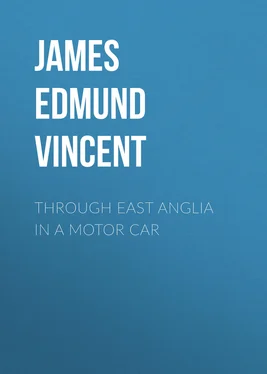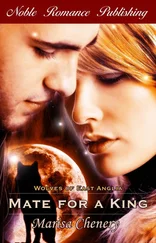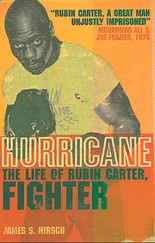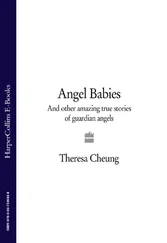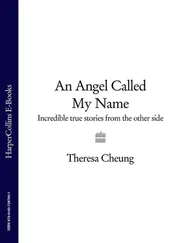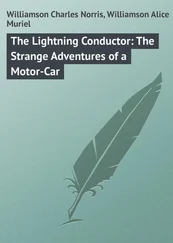James Vincent - Through East Anglia in a Motor Car
Здесь есть возможность читать онлайн «James Vincent - Through East Anglia in a Motor Car» — ознакомительный отрывок электронной книги совершенно бесплатно, а после прочтения отрывка купить полную версию. В некоторых случаях можно слушать аудио, скачать через торрент в формате fb2 и присутствует краткое содержание. Жанр: Путешествия и география, foreign_antique, foreign_prose, на английском языке. Описание произведения, (предисловие) а так же отзывы посетителей доступны на портале библиотеки ЛибКат.
- Название:Through East Anglia in a Motor Car
- Автор:
- Жанр:
- Год:неизвестен
- ISBN:нет данных
- Рейтинг книги:3 / 5. Голосов: 1
-
Избранное:Добавить в избранное
- Отзывы:
-
Ваша оценка:
- 60
- 1
- 2
- 3
- 4
- 5
Through East Anglia in a Motor Car: краткое содержание, описание и аннотация
Предлагаем к чтению аннотацию, описание, краткое содержание или предисловие (зависит от того, что написал сам автор книги «Through East Anglia in a Motor Car»). Если вы не нашли необходимую информацию о книге — напишите в комментариях, мы постараемся отыскать её.
Through East Anglia in a Motor Car — читать онлайн ознакомительный отрывок
Ниже представлен текст книги, разбитый по страницам. Система сохранения места последней прочитанной страницы, позволяет с удобством читать онлайн бесплатно книгу «Through East Anglia in a Motor Car», без необходимости каждый раз заново искать на чём Вы остановились. Поставьте закладку, и сможете в любой момент перейти на страницу, на которой закончили чтение.
Интервал:
Закладка:
The English claimed a victory and embalmed it in a ballad, although the truth was that the Duke's fleet was too much shattered for pursuit and the French fleet, under secret orders, perhaps, from Louis XIV, did next to nothing; the Dutch, probably, claimed one also, although the battle ended the hopes with which De Ruyter's expedition started. All that matters nothing now. The moment that heartens a man is that at which he stands on this low-lying shore, as spectators stood all the long day in May, 1672, and remembers the gallant fight and the glorious death of Sandwich. "Sir Isaac Newton is also said to have heard it [the firing] at Cambridge." So writes the accomplished author of Murray's Guide in 1875, and there is nothing incredible in the suggestion. The distance is but seventy miles, roughly; the cannon of old time with their black powder made a terrible sound; acoustics are full of mystery, and the noise of the big guns at Portsmouth is often heard in the heart of the Berkshire Downs. From Euston to the centre of Sole Bay is about half the distance over which sound is said to have reached Newton, and it is on record that Lord Ossory, then a guest of the Duke of Grafton, heard the guns and rode half-way across East Anglia to witness the battle. Surely it was a majestic and awe-inspiring spectacle for those on the shore, and surely it is worth while to reconstruct it now in imagination.
From Blythburgh we went along a road of poor surface, and of no scenic attraction in winter save that the trees were fine, to Beccles, one of the three principal towns of Suffolk, possessed, I was content to believe, of a grand church, and boasting a view over the marshes of the Waveney, once navigable. But we saw little of Beccles, the name of which reminded Edward Fitzgerald of "hooks and eyes"; we were indeed quite glad to leave it after penetrating a quarter suggestive of a new and prosperous Midland town, for election fever was running high, and car and its occupants were cheered or hooted by eager crowds; cheered most, perhaps, for the crowds were mostly "Red," and the Connemara cloak seemed to express a sympathy which, in truth, was not felt. We had all had enough electioneering and to spare and were glad to turn our faces for Lowestoft. As will be seen later, Beccles made a far more pleasant impression on a subsequent visit. At Lowestoft too—it is a short and easy run—election fever was running high, and the political excitement of a seething mob does not make for an individual appreciation of the picturesque. But old Lowestoft is picturesque, hanging, as it were, over the sea, and South Lowestoft has a peculiar origin worth knowing.
Among the pleasant enterprises incident to the writing of this book has been the making of notes from Norfolk and Norwich Notes and Queries , reprinted from the Norfolk Chronicle , to which I have added in my note-book O si sic omnes! Would indeed that all county papers laid themselves out, as this one does, to collect notes from those interested in the antiquities of their county. Here as to Lowestoft are found two notes, one entertaining and suggestive, the other distinctly taking. It appears that in 1558 one Thomas North published a fantastic explanation of the origin of herring curing, in which Lowestoft has always rivalled Yarmouth. Without giving it in detail, it may be stated that in essential spirit, if on a different topic, it exactly anticipates Charles Lamb's divine theory of roast pig; but Thomas North has none of that grace of expression which compels quotation when one encounters Lamb, and one only regrets that Lamb did not think of describing the origin of herring curing as well as of roast pork.
The second Lowestoft note deserves a paragraph to itself, for it is full of moral lessons, and a curious illustration of the way in which the overweening ambition of one community and the churlishness of a second has ended in loss to the first and in the profit of a third community to the prejudice of the second. In the records of St. Peter's Church, at Norwich (St. Peter's, Permountergate, if memory serves accurately, which is St. Peter's, Parmentersgate, or Tailors' Street), is an entry of 27 March, 1814: "Ringing the Bells for Norwich a Port. 10/6." Early in the last century, it appears, Norwich was a very important centre of the wool trade. Now Norwich thrives on mustard and boots, but let that pass; at the time in question wool was the staple trade, and it was exported by way of Yarmouth. In 1812 or thereabouts, like Manchester later, Norwich determined, if possible, to have direct communication with the sea. Enterprising men consulted William Cubitt, afterwards Sir William Cubitt, and a very distinguished engineer in matters relating to canals and docks. They probably consulted him mainly because he was a Norfolk man, for he was not yet thirty years old, and his fame, which was to be considerable, was yet to come. They sought the advice also of that consummate Scottish engineer, Thomas Telford, then well advanced in middle age and almost at the pinnacle of his fame. Alternative routes for the proposed canal were suggested, one by way of Yarmouth, the other by way of Lowestoft. Yarmouth, its safe trade threatened, opposed from the beginning, and eventually the Lowestoft route was adopted; the mouth of Lowestoft Harbour was cleared from the sands that blocked it, a cut was made connecting it with the Waveney through Oulton Broad, another cut from Haddiscoe to Reedham, and in 1814 the bells rang gaily to celebrate "Norwich a port." For Norwich it was a short-lived triumph, since the scheme did not pay its way, and in 1844 it was practically, possibly indeed formally, bankrupt. At any rate, the Lowestoft part of the works was bought outright by Sir Samuel Peto, who in that year—but whether before he acquired the harbour or not I cannot say—bought Somerleyton hard by, some time the seat of the Fitz-Osberts and the Jernigans, from Lord Sidney Godolphin Osborne. Sic vos, non vobis. The Norwich folk lost their money, or some of it; Sir Samuel Peto took Lowestoft in hand, "developed" it, as the saying goes, so that South Lowestoft became a flourishing seaside place; and finally Lowestoft as a port became a serious rival to Yarmouth. As a seaside place Lowestoft is pleasing to some tastes now, even as it was in the days when Edward Fitzgerald would betake himself thither from Woodbridge to spend his days in sailing and in writing letters which are a treasure to posterity; and his evenings in reading Shakespeare or Don Quixote with his close friends, Cowell and Aldis Wright, who often lodged at Lowestoft for a short time in summer. It would have been good to have their opinion upon the derivation of Lowestoft, appearing in Domesday as Lothu-wis-toft, which is said to be "the enclosure by the water of Loth," who in his turn is said to have been a Norse invader; but nothing is to be discovered of Loth, or Loo, save that Lake Lothing, now the inner harbour, is named after him, as was the hundred of Lothingland or Ludingaland; and Edward Fitzgerald is really much more interesting than a nebulous Norse pirate.
Election fever and its ravings, a short glance at picturesque features, and the inestimable blessings of tea and warmth are the principal memories left by this particular visit to Lowestoft. Thence we ran along the easy coast road in the darkness to Great Yarmouth, which, on this occasion, left no vivid impression on the memory. No such language, however, can be employed with regard to the remainder of that evening's drive. Doubts had arisen whether it would be wiser to make for Norwich by the more circuitous route which fetches a compass round Caister Castle, or by the "new road" running in a direct line for Acle first, across a salt marsh, and from Acle fairly straight for Norwich. The new road was much the shorter and, being across a salt marsh, a dead-level, but our local pilot was doubtful as to the state of its surface. However, it was decided to make inquiry at the toll-gate, a mile or so out of Yarmouth, and to abide by the answer, which was satisfactory. So was the road, so far as its surface went. It ran first for five miles straight as an arrow; the straightness was apparent at the time, but the five miles seemed like twenty. A fine mist was frozen over the watery land, nothing was visible on one side except, at stated intervals, a towering telegraph pole, and on both sides, at shorter intervals, were puny and poor trees which may have been poplars or willows. It became my duty, seated beside the man at the wheel, to peer into the darkness, trying to distinguish any possible obstacle or turn, to make out the character of any light that might be seen, and to watch for the bend, which, after another straight run of some three miles, would take us to Acle. As a rule I could just see the outline of one telegraph post as we passed its predecessor; there was, in all probability, a deep dyke on either side, and it was an ideal night for running into a country vehicle travelling without a tail light; but happily we encountered none. Indeed, although motorists complain much, late years have seen a great improvement in this respect. Of lights on approaching vehicles we saw one or two, appearing at first to be distant and stationary as a planet on a clear night, and then to be close to us in an instant. It was, in short, a trying experience to the nerves and to the eyes, and we resolved to avoid night journeys as much as might be in the future. The resolution was renewed when we looked at our strained and bloodshot eyes the next morning, and broken perforce the next evening; but night travelling by motor-car in winter is not to be recommended unless the moon is strong. It is a process to be resolved upon when circumstances suit, not to be planned in advance.
Читать дальшеИнтервал:
Закладка:
Похожие книги на «Through East Anglia in a Motor Car»
Представляем Вашему вниманию похожие книги на «Through East Anglia in a Motor Car» списком для выбора. Мы отобрали схожую по названию и смыслу литературу в надежде предоставить читателям больше вариантов отыскать новые, интересные, ещё непрочитанные произведения.
Обсуждение, отзывы о книге «Through East Anglia in a Motor Car» и просто собственные мнения читателей. Оставьте ваши комментарии, напишите, что Вы думаете о произведении, его смысле или главных героях. Укажите что конкретно понравилось, а что нет, и почему Вы так считаете.
